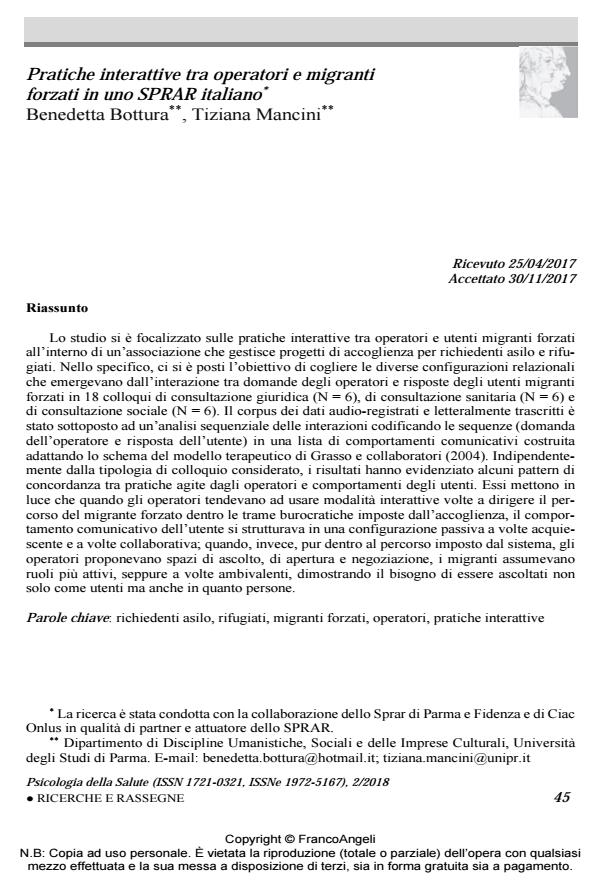Interactive practices between professionals and forced migrants inside an Italian reception association
Journal title PSICOLOGIA DELLA SALUTE
Author/s Benedetta Bottura, Tiziana Mancini
Publishing Year 2018 Issue 2018/2
Language Italian Pages 25 P. 45-69 File size 289 KB
DOI 10.3280/PDS2018-002007
DOI is like a bar code for intellectual property: to have more infomation
click here
Below, you can see the article first page
If you want to buy this article in PDF format, you can do it, following the instructions to buy download credits

FrancoAngeli is member of Publishers International Linking Association, Inc (PILA), a not-for-profit association which run the CrossRef service enabling links to and from online scholarly content.
The study has focused on the interactive practices between professionals and forced migrants into a NGO for the welcome of asylum seekers and refugees. Specifically, it was aimed to collect the different relational configurations that emerged from the interaction between professionals’ queries and forced migrants’ replies in 18 consultations divided in: legal consultations (N = 6), health consultations (N = 6) and social consultations (N = 6). Consultations have been audio-recorded and literally transcribed. Data were analyzed using the sequential analysis of interactions and by coding sequences ‒ professionals’ queries and forced migrants’ replies ‒ through a list of communicative behaviors adapted from the therapeutic model of Grasso and coworkers (2004). Regardless of the type of consultation, the results showed some concordat patterns between the practices of the professionals and the communicative behaviors of the forced migrants. These patterns showed that when the professionals used interactive modes for leading forced migrants along the bureaucratic paths imposed by the asylum system, forced migrants showed a more passive - collaborative or acquiescent ‒ profile. However, when the professionals proposed some listening and negotiating spaces, forced migrants assumed a more active - even if sometimes ambiguous ‒ role, demonstrating the need to be heard not only as a "user" but also as a person.
Keywords: Asylum seekers, refugees, forced migrants, professionals, interactive practices
- Living in a multicultural context: Health and integration from the perspective of undocumented Mediterranean migrants, residents, and stakeholders in Italy. A qualitative‐multimethod study Mariachiara Figura, Paola Arcadi, Ercole Vellone, Gianluca Pucciarelli, Silvio Simeone, Loredana Piervisani, Rosaria Alvaro, in Journal of Advanced Nursing /2024 pp.3382
DOI: 10.1111/jan.16036
Benedetta Bottura, Tiziana Mancini, Pratiche interattive tra operatori e migranti forzati in uno SPRAR italiano in "PSICOLOGIA DELLA SALUTE" 2/2018, pp 45-69, DOI: 10.3280/PDS2018-002007